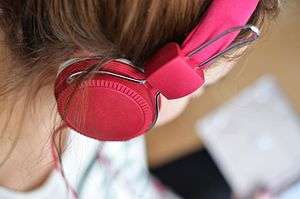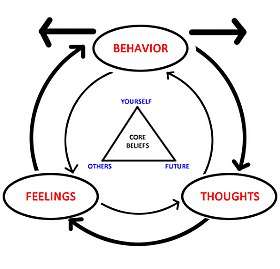Misophonia
Misophonia, meaning "hatred of sound", was proposed in 2000 as a condition in which negative emotions, thoughts, and physical reactions are triggered by specific sounds.
| Misophonia | |
|---|---|
| Other names | Selective Sound Sensitivity Syndrome[1], Select sound sensitivity syndrome, sound-rage[2][3] |
 | |
| People who are sensitive to certain sounds sometimes cope by blocking them out. | |
Misophonia is not classified as an auditory or psychiatric condition, and so is different from phonophobia (fear of sound); there are no standard diagnostic criteria, and there is little research on how common it is or the treatment. Proponents suggest misophonia can adversely affect the ability to achieve life goals and to enjoy social situations. As of 2019 there were no evidence-based methods to manage the condition.
Signs and symptoms
As of 2016 the literature on misophonia was limited.[2] Some small studies show that people with misophonia generally have strong negative feelings, thoughts, and physical reactions to specific sounds, which the literature calls "trigger sounds". These sounds are apparently usually soft, but can be loud. One study found that around 80% of the sounds were related to the mouth (eating, slurping, chewing or popping gum, whispering, whistling, etc.), and around 60% were repetitive. A visual trigger may develop related to the trigger sound.[2][4] It also appears that a misophonic reaction can occur in the absence of an actual sound.[2]
Reactions to the triggers can include aggression toward the origin of the sound, leaving, remaining in its presence but suffering, trying to block it or trying to mimic the sound.[4]
The first misophonic reaction may occur when a person is young and can originate from someone in a close relationship, or a pet.[4]
Particularly severe cases of misophonia may result in violent impulses toward the source of the sound. One such case described in the journal Psychiatry and Clinical Psychopharmacology detailed 'involuntary violence' exhibited by a sufferer in response to a trigger in the form of another person eating loudly.[5]
People with misophonia are aware they experience it and some consider it abnormal; the disruption it causes in their lives ranges from mild to severe.[4] Avoidance and other behaviors can make it harder for people with this condition to achieve their goals and enjoy interpersonal interactions.[3]
Mechanism
Misophonia's mechanism is not known, but it appears that, like hyperacusis, it may be caused by a dysfunction of the central auditory system in the brain and not of the ears.[2] The perceived origin and context of the sound appears to be essential to trigger a reaction.[2]
A 2017 study found that the anterior insular cortex (which plays a role both in emotions like anger and in integrating outside input, such as sound, with input from organs such as the heart and lungs) causes more activity in other parts of the brain in response to triggers, particularly in the parts responsible for long-term memories, fear, and other emotions. It also found that people with misophonia have higher amounts of myelin (a fatty substance that wraps around nerve cells in the brain to provide electrical insulation). It is not clear whether myelin is a cause or an effect of misophonia and its triggering of other brain areas.[6][7]
Diagnosis
There are no standard diagnostic criteria.[4] Misophonia is distinguished from hyperacusis, which is not specific to a given sound and does not involve a similar strong reaction, and from phonophobia, which is a fear of a specific sound,[4] but it may occur with either.[8]
It is not clear whether people with misophonia usually have comorbid conditions, nor whether there is a genetic component.[4]
Classification
The diagnosis of misophonia is not recognized in the DSM-IV or the ICD 10, and it is not classified as a hearing or psychiatric disorder.[4] It may be a form of sound–emotion synesthesia, and has parallels with some anxiety disorders.[2] As of 2018 it was not clear if misophonia should be classified as a symptom or as a condition.[3]
Management

As of 2018 there are no evidence-based treatments for the condition and no randomized clinical trial has been published; health care providers generally try to help people cope with misophonia by recognizing what the person is experiencing and working on coping strategies.[2][4] Some small studies have been published on the use of sound therapy similar to tinnitus retraining therapy and on cognitive behavioral therapy and particularly exposure therapy, to help people become less aware of the trigger sound.[2][3] None of these approaches has been sufficiently studied to determine its effectiveness.[3][9]
Epidemiology
The prevalence is not yet known; it is not known whether males or females, or older or younger people, are more likely to have misophonia.[2][4]
The existence of several online support groups with thousands of members has been cited as possibly indicative of its prevalence.[10]
Etymology
"Misophonia" comes from the Greek words μίσος (mee-sos = hate) and φωνή (phó-nè = voice), loosely meaning "hate of sound", and was coined by audiologists Pawel and Margaret Jastreboff in 2000 to differentiate the condition from other forms of decreased sound tolerance such as hyperacusis (hypersensitivity to certain frequencies and volume ranges) and phonophobia (fear of sounds).[3][9][11]
Society and culture
People who experience misophonia have formed online support groups.[12][10]
In 2016, Quiet Please, a documentary about misophonia, was released.[13][14]
References
- Sanchez, TG (2017). ""Familial misophonia or selective sound sensitivity syndrome : evidence for autosomal dominant inheritance?"". "Brazilian Journal of Otorhinolaryngology". 84 (5): 553–559. doi:10.1016/j.bjorl.2017.06.014". PMID 28823694.
- Bruxner, G (2016). "'Mastication rage': a review of misophonia—an under-recognised symptom of psychiatric relevance?". Australasian Psychiatry. 24 (2): 195–197. doi:10.1177/1039856215613010. PMID 26508801.
- Cavanna AE, Seri S (Aug 2015). "Misophonia: current perspectives". Neuropsychiatr Dis Treat. 11: 2117–23. doi:10.2147/NDT.S81438. PMC 4547634. PMID 26316758.
- Duddy DF, Oeding KA (2014). "Misophonia: An Overview". Semin Hear. 35 (2): 084–091. doi:10.1055/s-0034-1372525.
- Tunç, Serhat (2017). "An extreme physical reaction in misophonia: stop smacking your mouth!". Psychiatry and Clinical Psychopharmacology. Psychiatry and Clinical Psychopharmacology. 27 (4): 416–418. doi:10.1080/24750573.2017.1354656.
- PhD, James Cartreine (21 April 2017). "Misophonia: When sounds really do make you "crazy"". Harvard Health Blog.
- Kumar, Sukhbinder; Tansley-Hancock, Olana; Sedley, William; Winston, Joel S.; Callaghan, Martina F.; Allen, Micah; Cope, Thomas E.; Gander, Phillip E.; Bamiou, Doris-Eva; Griffiths, Timothy D. (20 February 2017). "The Brain Basis for Misophonia". Current Biology. 27 (4): 527–533. doi:10.1016/j.cub.2016.12.048. ISSN 0960-9822. PMC 5321671. PMID 28162895.
- Jastreboff PJ, Jastreboff MM (2015). Decreased sound tolerance: hyperacusis, misophonia, diplacousis, and polyacousis. Handb Clin Neurol. Handbook of Clinical Neurology. 129. pp. 375–87. doi:10.1016/B978-0-444-62630-1.00021-4. ISBN 9780444626301. PMID 25726280.
- Cavanna, Andrea E. (2014-04-01). "What is misophonia and how can we treat it?". Expert Review of Neurotherapeutics. 14 (4): 357–359. doi:10.1586/14737175.2014.892418. ISSN 1744-8360. PMID 24552574.
- Denys, Damiaan; Vulink, Nienke; Schröder, Arjan (23 January 2013). "Misophonia: Diagnostic Criteria for a New Psychiatric Disorder". PLOS ONE. 8 (1): e54706. Bibcode:2013PLoSO...854706S. doi:10.1371/journal.pone.0054706. ISSN 1932-6203. PMC 3553052.
- Jastreboff, Margaret M.; Jastreboff, Pawel J. (2001). "Components of decreased sound tolerance : hyperacusis, misophonia, phonophobia" (PDF).
- Cohen, Joyce (September 5, 2011). "When a Chomp or a Slurp is a Trigger for Outrage". The New York Times. Retrieved February 5, 2012.
- Jeffries, Adrianne (June 17, 2016). "There's a New Film About Misophonia, Where People Get Enraged by Certain Sounds". Motherboard.
- Garcy, Pamela D. (January 27, 2016). "What Jeffrey S. Gould Can Teach Us about Misophonia". Psychology Today.
- Lerner, Barron H. (2015-03-02). "Please Stop Making That Noise". Well. New York Times. Retrieved 2016-10-18.
- Misophonia: Kelly Ripa Has Rare Disorder. 20/20. ABC News. 2012-05-18. Retrieved 2016-10-18.
- Bisley, Interview by Alexander (2015-03-10). "Melanie Lynskey on Togetherness, realism and 'radical' nudity". The Guardian. ISSN 0261-3077. Retrieved 2017-06-30.
- Dawson, Shane (2019-07-22). "Tweet". Retrieved 2019-07-22.